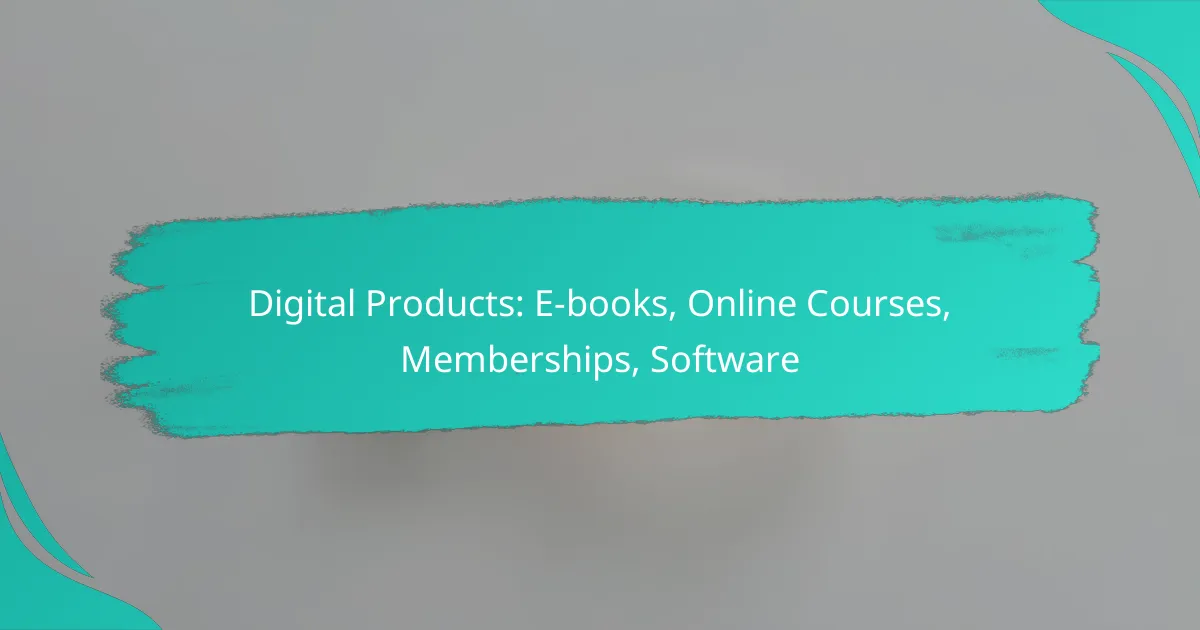Digital products like e-books, online courses, memberships, and software solutions provide Canadian consumers with flexible and accessible options to enhance their skills or enjoy entertainment. By understanding your specific needs and preferences, you can choose the right product that aligns with your goals and budget. With various pricing models available, including one-time purchases and subscriptions, there are opportunities to find the best fit for your lifestyle.

What are the best digital products for Canadian consumers?
The best digital products for Canadian consumers include e-books, online courses, memberships, and software solutions that cater to various interests and needs. These products offer flexibility, accessibility, and often a cost-effective way to enhance skills or enjoy entertainment.
E-books for self-improvement
E-books focused on self-improvement cover topics like personal finance, mental health, productivity, and wellness. Popular platforms such as Amazon Kindle and Kobo offer a wide range of titles, often priced between CAD 5 to CAD 20, making them affordable options for readers.
When selecting e-books, consider reviews and ratings to ensure quality content. Look for authors with expertise in their subject matter and check for updated editions to stay current with trends and techniques.
Online courses from Coursera
Coursera provides a vast array of online courses from top universities and institutions, covering subjects from programming to business management. Many courses are free to audit, while certificates typically range from CAD 50 to CAD 300, depending on the program.
To maximize your learning experience, choose courses that offer hands-on projects or peer interactions. Check the course duration and commitment level to ensure it fits your schedule and learning goals.
Memberships on Patreon
Patreon allows creators to offer memberships for exclusive content, ranging from art and music to educational resources. Membership tiers often start as low as CAD 1 per month and can go up to CAD 50 or more, depending on the benefits provided.
When considering a Patreon membership, evaluate the creator’s engagement and the value of the content offered. Look for creators who provide regular updates and interact with their supporters to enhance your experience.
Software solutions like Adobe Creative Cloud
Adobe Creative Cloud is a suite of software tools used for graphic design, video editing, and web development. Subscriptions typically range from CAD 10 to CAD 80 per month, depending on the plan and applications included.
Before subscribing, assess your specific needs and the software features you will use most. Take advantage of free trials to explore the tools and ensure they meet your requirements before committing to a subscription.

How to choose the right digital product?
Choosing the right digital product involves understanding your specific needs and preferences. Consider factors such as your learning goals, product reviews, and pricing structures to make an informed decision.
Identify your learning goals
Start by clarifying what you hope to achieve with the digital product. Are you looking to gain new skills, enhance existing knowledge, or pursue a hobby? Defining your objectives will guide your selection process.
For instance, if your goal is to advance in your career, seek out e-books or online courses that offer certifications or industry-recognized credentials. If you’re exploring a new interest, a membership site with diverse resources may be more suitable.
Evaluate product reviews
Product reviews provide valuable insights into the effectiveness and quality of digital offerings. Look for feedback from users who share similar goals to yours, as their experiences can highlight strengths and weaknesses.
Check platforms like Trustpilot or course-specific sites for ratings and comments. Pay attention to recurring themes in reviews, such as the clarity of content, user support, and overall satisfaction. This can help you avoid products that may not meet your expectations.
Consider pricing and subscription models
Pricing is a crucial factor when selecting a digital product. Evaluate whether a one-time purchase or a subscription model fits your budget and learning style. Subscriptions can offer ongoing access to updated content, while one-time purchases may provide specific resources without recurring costs.
For example, online courses may range from $50 to several hundred dollars, while memberships might charge monthly fees between $10 and $30. Compare what each option offers in terms of content, support, and additional resources to ensure you get the best value for your investment.

What are the pricing models for digital products?
Digital products typically utilize various pricing models, each suited to different types of offerings. Common models include one-time purchases, subscriptions, tiered memberships, and freemium options, each with unique advantages and considerations.
One-time purchase for e-books
One-time purchase pricing for e-books allows customers to buy the book outright, often at a fixed price. This model is straightforward, appealing to readers who prefer ownership without ongoing commitments.
Prices for e-books can vary widely, generally ranging from a few dollars to over twenty dollars, depending on the author’s reputation and the book’s content. Authors should consider offering discounts or promotions to boost initial sales.
Subscription-based online courses
Subscription-based online courses charge users a recurring fee, typically monthly or annually, granting access to a library of courses. This model encourages ongoing learning and can provide a steady revenue stream for course creators.
Prices for subscriptions often range from around $10 to $50 per month, depending on the course quality and the number of offerings. Creators should ensure that the content remains fresh and engaging to retain subscribers.
Tiered membership pricing
Tiered membership pricing offers different levels of access at varying price points, allowing users to choose a plan that fits their needs. This model can cater to diverse audiences by providing basic to premium features.
Membership tiers might range from a low-cost entry level at around $5 per month to a premium tier exceeding $50 per month. It’s essential to clearly define the benefits of each tier to encourage upgrades and maximize revenue.
Freemium software models
Freemium software models provide basic features for free while charging for advanced functionalities. This approach attracts a large user base, with the goal of converting free users into paying customers over time.
Commonly, the free version includes essential tools, while premium features can range from $10 to $100 per month, depending on the software’s complexity. Developers should focus on creating compelling premium features that entice users to upgrade.

What are the benefits of digital products?
Digital products offer numerous advantages, including convenience, affordability, and a diverse selection. They can be accessed easily from various devices and locations, making them a popular choice for consumers and businesses alike.
Accessibility from anywhere
One of the primary benefits of digital products is their accessibility. Users can access e-books, online courses, memberships, and software from any device with an internet connection, whether at home, in a café, or while traveling.
This flexibility allows individuals to learn or utilize tools at their own pace and convenience. For example, online courses can be taken on a smartphone during commutes, making it easier to fit education into busy schedules.
Cost-effectiveness
Digital products often come at a lower price point compared to their physical counterparts. E-books typically cost less than printed books, and online courses can be more affordable than traditional classroom settings.
Additionally, there are no shipping fees or physical storage requirements, which can further reduce costs. Many platforms also offer subscription models for memberships, allowing users to access a wide range of content for a monthly fee, often resulting in significant savings.
Wide variety of options
The digital marketplace is vast, offering a wide variety of products to meet diverse needs. From self-help e-books to specialized software for businesses, there is something for everyone.
Consumers can choose from numerous formats and subjects, ensuring they find the right fit for their interests or professional requirements. For instance, online learning platforms provide courses on topics ranging from programming to photography, catering to different skill levels and preferences.

What are the challenges of digital products?
Digital products face several challenges that can impact their success, including market saturation, pricing strategies, and customer engagement. Understanding these challenges is crucial for creators and marketers to effectively navigate the digital landscape.
Market Saturation
Market saturation occurs when the number of digital products exceeds consumer demand, making it difficult for new offerings to gain traction. This is particularly evident in popular categories like e-books and online courses, where countless options are available. To stand out, focus on niche topics or unique selling propositions that differentiate your product.
Researching competitors can help identify gaps in the market. Tools like Google Trends or keyword analysis can provide insights into what consumers are searching for, allowing you to tailor your offerings accordingly.
Pricing Strategies
Determining the right price for digital products can be challenging. Prices that are too high may deter potential buyers, while prices that are too low can undermine perceived value. Consider using tiered pricing models or offering introductory discounts to attract initial customers.
It’s essential to analyze your target audience’s willingness to pay and compare your pricing with similar products. Offering bundled deals or subscription models can also enhance perceived value and encourage long-term engagement.
Customer Engagement
Maintaining customer engagement is vital for the success of digital products. With numerous distractions online, it can be challenging to keep users interested. Regular updates, interactive content, and community-building efforts can help foster a loyal customer base.
Utilizing email marketing and social media platforms to communicate with customers can enhance engagement. Providing valuable content, such as free resources or exclusive insights, can also encourage repeat interactions and strengthen relationships.
